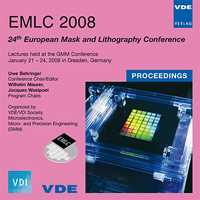Theoretical Study of Mask Haze Formation
Konferenz: EMLC 2008 - 24th European Mask and Lithography Conference
21.01.2008 - 24.01.2008 in Dresden, Germany
Tagungsband: EMLC 2008
Seiten: 11Sprache: EnglischTyp: PDF
Persönliche VDE-Mitglieder erhalten auf diesen Artikel 10% Rabatt
Autoren:
Wu, Banqiu; Kumar, Ajay (Applied Materials, Inc., 974 E. Arques Ave, M/S 81505, Sunnyvale, CA 94085, USA)
Inhalt:
Studies on the haze formation mechanism in deep ultraviolet (UV) lithography were carried out. A nucleation and growth model on haze formation was proposed based on Gibbs energy change analysis. Haze formation is a nucleation and growth process. For a spontaneous process, Gibbs energy change in nucleation results from surface energy increase and volume energy decrease; the former tends to prevent nucleation and the latter to enhance it. Then, a critical dimension of nuclei exists, i.e. when a nucleus is larger than critical dimension, it can grow with a system Gibbs energy decrease. The study shows that it is thermodynamically spontaneous for small haze to merge with large haze. A critical distance exists, beyond which nuclei grow independently. The haze formation region on a plot of composition versus temperature was proposed based on the equilibrium constant calculation and a haze growth mechanism postulated. Photochemical dissociation of molecular oxygen to atomic oxygen by excimer laser less than 246 nm wavelength plays an important role in the oxidation of sulfur dioxide. The proposed mechanism agreed well with previously published experimental results.


